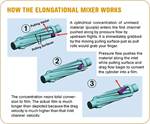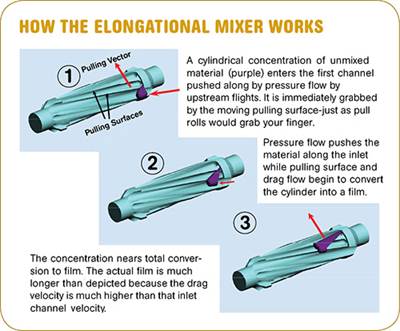New Frontier for Single Screw R&D: Mixing & Melting by Extensional Shear
Extrusion Know How
Extensional shear generally has been associated only with twin-screw extruders. However, I am now convinced it can be done with a single moving force (screw) by changing the geometry of the flow field perpendicular to the direction of flow.
There are many types of single-screw mixers on the market, and they can be generally categorized as either distributive or dispersive, all having some degree of each. Distributive mixing is more “macro” mixing—that is, the components of the mix are equally distributed. Dispersive mixing tends to be more on the “micro” level, where high stresses are imparted to the lesser component through viscous shear of the surrounding polymer to obtain high levels of integration. For dispersive mixing, there is a second mixing mechanism to be considered besides simple shear. It is extensional shear, which generally has been associated only with twin-screw extruders.
However, some have recently promoted the concept in single-screw mixing. I was originally skeptical about the idea because I felt there had to be two moving forces to develop such mixing.
However, after meeting with Keith Luker of Randcastle Extrusion, Cedar Grove, N.J., I became convinced it can be done with a single moving force (screw) by changing the geometry of the flow field perpendicular to the direction of flow. An example of extensional shear is depicted in the accompanying illustration of fiber extrusion. Note simple shear in the die orifice and extensional shear where the cross-section of the fiber is being continually reduced through drawdown.
This is important because the viscosity of polymers in extension is approximately three times the viscosity in tangential or simple shear (Trouton’s ratio). The higher the viscosity of a material, the more effective it is to mix another material into it. By mixing in the extensional mode the higher (3X) viscosity greatly increases the dispersive effect, breaking down the lesser component with three times the shear stress. Additionally, extensional shear does not reduce the viscosity by shear thinning like simple shear does, so that the viscosity remains high even at high shear rates. This would be particularly effective for polymers exhibiting high non-Newtonian (shear-thinning) behavior.
Luker has taken this concept further with single-screw “mixers” that are intended to be both primary melting devices and intensive mixers). He uses extensional shear to increase the viscous dissipation through the viscosity multiplier. His tests show melting can occur in very short distances when extensional shear is employed in the design. This replicates the extensional shear melting that occurs in twin screws, where all solids can be melted in as little as one screw diameter.
Design of these mixers requires a lot of thought for application to single screws—there has to be a big change in shape of the melt flow in order to develop a shear field of any intensity perpendicular to the main flow field. It’s hard to visualize a screw geometry where the polymer is stretched in one dimension while compressed in another direction (as in the fiber drawdown illustration) without a pressure drop. And, extensional shear has to happen simultaneously with the simple shear occurring in the screw channel from the screw’s rotation relative to the barrel.
At this point, I can visualize doing this only with a pressure drop to change the melt flow’s shape independent of the simple shear from screw rotation. Both Luker and Chris Rauwendaal of Rauwendaal Extrusion Engineering, Auburn, Calif., employ a pressure drop in their designs to accomplish this. Pressure drops limit output and generate excessive temperature from pressure flow in the screw channels, so the addition of these devices will require changes in the entire screw design to be effective.
But properly designed extensional shear devices have the potential to reduce screw length while increasing the effectiveness of mixing and melting. If all polymer in the screw can be subjected to equal levels of extensional mixing, the potential for dispersive mixing is 3n times that of a traditional screw with the same shear rate (“n” being the number of passes through an extensional shear field).
In retrospect, I see evidence of elongational shear flow in many older mixers and screw designs, which may explain how some are surprisingly efficient at mixing and/or melting in such a small area. Maximizing elongational shear flow in single-screw extrusion may be the most significant step since the barrier screw.
Related Content
The Effects of Stress on Polymers
Previously we have discussed the effects of temperature and time on the long-term behavior of polymers. Now let's take a look at stress.
Read MoreThree Key Decisions for an Optimal Ejection System
When determining the best ejection option for a tool, molders must consider the ejector’s surface area, location and style.
Read MoreBack to Basics on Mold Venting (Part 2: Shape, Dimensions, Details)
Here’s how to get the most out of your stationary mold vents.
Read MoreHow to Select the Right Cooling Stack for Sheet
First, remember there is no universal cooling-roll stack. And be sure to take into account the specific heat of the polymer you are processing.
Read MoreRead Next
Study May Boost Prospects For Single-Screw ‘Elongator’
Dow Chemical Co., Midland, Mich., weighed in at last year’s SPE ANTEC with a paper discussing results of experiments they conducted on a novel elongational mixing device developed by Randcastle Extrusion Systems
Read MoreFor PLASTICS' CEO Seaholm, NPE to Shine Light on Sustainability Successes
With advocacy, communication and sustainability as three main pillars, Seaholm leads a trade association to NPE that ‘is more active today than we have ever been.’
Read More
.jpg;width=70;height=70;mode=crop)



















